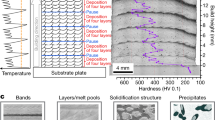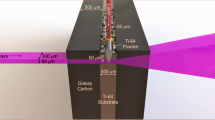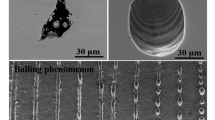Abstract
The use of microwaves to process absorbing materials was studied intensively in the 1970s and 1980s, and has now been applied to a wide variety of materials1,2,3,4. Initially, success in microwave heating and sintering was confined mainly to oxide and some non-oxide ceramics5,6,7,8,9,10,11; but recently the technique has been extended to carbide semimetals12,13,14 used in cutting tools. Here we describe the microwave sintering of powdered metals to full density. We are able to sinter a wide range of standard powdered metals from commercial sources using a 2.45-GHz microwave field, yielding dense products with better mechanical properties than those obtained by conventional heating. These findings are surprising in view of the reflectivity of bulk metals at microwave frequencies. The ability to sinter metals with microwaves should assist in the preparation of high-performance metal parts needed in many industries, for example, in the automotive industry.
This is a preview of subscription content, access via your institution
Access options
Subscribe to this journal
Receive 51 print issues and online access
$199.00 per year
only $3.90 per issue
Buy this article
- Purchase on Springer Link
- Instant access to full article PDF
Prices may be subject to local taxes which are calculated during checkout


Similar content being viewed by others
References
Clark, D. & Sutton, W. H. Microwave processing of materials. Annu. Rev. Mater. Sci. 26, 299– 331 (1996).
Schiffman, R. F. Commercializing microwave systems: Paths to success or failure. Ceram. Trans. 59, 7–17 ( 1995).
Katz, J. D. Microwave sintering of ceramics. Annu. Rev. Mater. Sci. 22, 153–170 (1992).
Sutton, W. Microwave processing of ceramics: an overview. Mater. Res. Soc. Symp. Proc. 269, 3–19 ( 1992).
Sutton, W. Microwave processing of ceramic materials. Am. Ceram. Soc. Bull. 68, 376–386 ( 1989).
Fang, Y., Agrawal, D. K., Roy, D. M. & Roy, R. Fabrication of transparent hydroxyapatite ceramics by microwave processing. Mater. Lett. 23, 147–151 (1995).
Agrawal, D. K., Fang, Y., Roy, D. M. & Roy, R. Mater. Res. Soc. Symp. Proc. 269, 231–236 ( 1992).
Fang, Y., Agrawal, D. K., Roy, D. M. & Roy, R. Fabrication of porous hydroxyapatite ceramics by microwave processing. J. Mater. Res. 7, 490–494 ( 1992).
Fang, Y., Roy, R., Agrawal, D. K. & Roy, D. M. Transparent mullite ceramics from diphasic aerogels by microwave and conventional processing. Mater. Lett. 28, 11–15 (1996).
Fang, Y., Agrawal, D. K., Roy, D. M. & Roy, R. Microwave sintering of calcium strontium zirconium phosphate ceramics. Ceram. Trans. 36, 109 (1993).
Fang, Y., Agrawal, D. K., Roy, D. & Roy, R. Microwave sintering of hydroxyapatite-based composites. Ceram. Trans. 36 , 397 (1993).
Roy, R., Agrawal, D., Cheng, J. P. & Mathis, M. Microwave processing: triumph of applications-driven science in WC-composites and ferroic titanates. Ceram. Trans. 80, 3–26 (1997).
Cheng, J. P., Agrawal, D. K., Komarneni, S., Mathis, M. & Roy, R. Microwave processing of WC-Co composites and ferroic titanates. Mater. Res. Innov. 1, 44–52 (1997).
Gerdes, T. & Willert-Porada, M. Mater. Res. Soc. Symp. Proc. 347, 531–537 ( 1996).
Walkiewicz, J. W., Kazonich, G. & McGill, S. L. Microwave heating characteristics of selected minerals and compounds. Min. Metall. Processing 5, 39–42 (1988).
Willert-Porada, M., Gerdes, T., Rodiger, K. & Kolaska, H. Einsatz von Mikrowellen zum Sintern pulvermetallurgischer Prudukte. Metall 50, 744–752 (1996).
Nishitani, T. Method for sintering refractories and an apparatus therefor.US Patent No. 4147911 (1979).
Whittaker, A. G. & Mingos, D. M. Microwave-assisted solid-state reactions involving metal powders. J. Chem. Soc. Dalton Trans. 2073–2079 (1995).
German, R. M. Sintering Theory and Practice(Wiley, New York, 1996 ).
Gedevanishvili, S., Agrawal, D. & Roy, R. Microwave combustion synthesis and sintering of intermetallics and alloys. Mater. Sci. Lett.(submitted).
Cherradi, A., Desgardin, G., Provost, J. & Raveau, B. Electric magnetic field contributions to the microwave sintering of ceramics. In Electroceramics IV Vol. II,(eds. Wasner, R., Hoffmann, S., Bonnenberg, D. & Hoffmann, C.) 1219–1224 (RWTN, Aachen, 1994).
Shanker, B. & Lakhtakia, A. Extended Maxwell Garnett formalism for composite adhesives for microwave-assisted adhesion of polymer surfaces. J. Compos. Mater. 27, 1203– 1213 (1993).
Acknowledgements
We thank J. Kosco for providing powdered-metal components. We also thank the approximately 20 corporations that supported the early stages of this work, which is now supported by the Electric Power Research Institute, the Keystone Powder Metal Company and the Ben Franklin Technology Center.
Author information
Authors and Affiliations
Corresponding author
Supplementary Information
Rights and permissions
About this article
Cite this article
Roy, R., Agrawal, D., Cheng, J. et al. Full sintering of powdered-metal bodies in a microwave field. Nature 399, 668–670 (1999). https://doi.org/10.1038/21390
Received:
Accepted:
Issue Date:
DOI: https://doi.org/10.1038/21390
This article is cited by
-
Computational Modeling and Simulation of the Microwave Hybrid Heating Process: A State of the Art Review
Archives of Computational Methods in Engineering (2024)
-
Progress in processing of porous titanium: a review
Rare Metals (2024)
-
Comparison of Microwave Versus Conventional Furnace Heat Treatments of Carbide Composite Thermal Spray Coatings
Journal of Thermal Spray Technology (2024)
-
Characterization of Inconel 625-SS 304 Weldments Developed by Selective Microwave Hybrid Joining Technique for Promising Applications
Journal of Materials Engineering and Performance (2023)
-
Sustainable approach for dissimilar joining of austenitic (SS316L)-ferritic (SS-430) stainless steel using microwave energy
International Journal on Interactive Design and Manufacturing (IJIDeM) (2023)
Comments
By submitting a comment you agree to abide by our Terms and Community Guidelines. If you find something abusive or that does not comply with our terms or guidelines please flag it as inappropriate.



